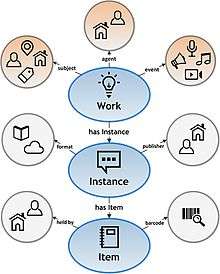BIBFRAME
BIBFRAME (Bibliographic Framework) is a data model for bibliographic description. BIBFRAME was designed to replace the MARC standards, and to use linked data principles to make bibliographic data more useful both within and outside the library community.[1]
History
The MARC Standards, which BIBFRAME seeks to replace, were developed by Henriette Avram[2] at the US Library of Congress during the 1960s. By 1971, MARC formats had become the national standard for dissemination of bibliographic data in the United States, and the international standard by 1973.
In a provocatively titled 2002 article, library technologist Roy Tennant argued that "MARC Must Die", noting that the standard was old; used only within the library community; and designed to be a display, rather than a storage or retrieval format.[3] A 2008 report from the Library of Congress wrote that MARC is "based on forty-year old techniques for data management and is out of step with programming styles of today."[4]
In 2012, the Library of Congress announced that it had contracted with Zepheira, a data management company, to develop a linked data alternative to MARC.[5] Later that year, the library announced a new model called MARC Resources (MARCR).[6] That November, the library released a more complete draft of the model, renamed BIBFRAME.[1] [nb 1]
The Library of Congress released version 2.0 of BIBFRAME in 2016.[7][8]
Design

BIBFRAME is expressed in RDF and based on three categories of abstraction (work, instance, item), with three additional classes (agent, subject, event) that relate to the core categories.[7] While the work entity in BIBFRAME may be "considered as the union of the disjoint work and expression entities"[9] in IFLA's Functional Requirements for Bibliographic Records (FRBR) entity relationship model, BIBFRAME's instance entity is analogous to the FRBR manifestation entity. This represents an apparent break with FRBR and the FRBR-based Resource Description and Access (RDA) cataloging code.[10] However, the original BIBFRAME model argues that the new model "can reflect the FRBR relationships in terms of a graph rather than as hierarchical relationships, after applying a reductionist technique."[1] Since both FRBR and BIBFRAME have been expressed in RDF, interoperability between the two models is technically possible.[11]
Specific formats
The BIBFRAME model includes a serial entity for journals, magazines, and other periodicals. Several issues have prevented the model from being used for serials cataloging.[12] BIBFRAME lacks several serials-related data fields available in MARC.[13]
A 2014 report was optimistic about BIBFRAME's suitability for describing audio and video resources, but also expressed concern about the high-level Work entity, which is unsuitable for modeling certain audio resources.[14]
Implementations
Related initiatives and standards
- RDA, FRBR, FRBRoo, FRAD, and FRSAD are available in RDF in the Open Metadata Registry, a metadata registry.[18]
- Schema Bib Extend project, a W3C-sponsored community group has worked to extend Schema.org to make it suitable for bibliographic description.[19]
See also
Notes
- For a detailed history of discontent with the MARC standards between Tennant's 2002 article and the 2012 announcement of BIBFRAME, see Kroeger, Angela (2013). "The Road to BIBFRAME: The Evolution of the Idea of Bibliographic Transition into a Post-MARC Future". Cataloging & Classification Quarterly. 51 (8): 873–890. doi:10.1080/01639374.2013.823584.
References
- Miller, Eric; Uche Ogbuji; Victoria Mueller; Kathy MacDougall (21 November 2012). Bibliographic Framework as a Web of Data: Linked Data Model and Supporting Services (PDF) (Report). Library of Congress. Retrieved 28 May 2014.
- Schudel, Matt. "Henriette Avram, 'Mother of MARC,' Dies". Library of Congress. Retrieved June 22, 2013.
- Tennant, Roy. "MARC Must Die". Library Journal. 127 (17): 26–27.
- On the Record (PDF) (Report). The Library of Congress Working Group on the Future of Bibliographic Control. 9 January 2008.
- "The Library of Congress Announces Modeling Initiative". BIBFRAME. Library of Congress. Retrieved 28 May 2014.
- McCallum, Sally (13 September 2012). "Bibliographic Framework Initiative Approach for MARC Data as Linked Data". 7th Annual IGeLU Conference. Retrieved 30 May 2014.
- "Overview of the BIBFRAME 2.0 Model". Library of Congress. Library of Congress. 21 Apr 2016. Retrieved 6 July 2016.
- McCallum, Sally (2017). "BIBFRAME Development". JLIS.it. 8 (3): 71–85. doi:10.4403/jlis.it-12415.
- Zapounidou, Sofia; Sfakakis, Michalis; Papatheodorou, Christos (2016-06-01). "Representing and integrating bibliographic information into the Semantic Web: A comparison of four conceptual models" (PDF). Journal of Information Science. 43 (4): 525–553. doi:10.1177/0165551516650410.
- Mitchell, Erik. "Three Case Studies in Linked Open Data". Library Technology Reports. 49 (5): 26–43.
- Zapounidou, Sofia; Sfakakis, Michalis; Papatheodorou, Christos (November 19–22, 2013). "Highlights of Library Data Models in the Era of Linked Open Data". In Emmanouel Garoufallou; Jane Greenberg (eds.). Metadata and Semantics Research. Metadata and Semantics Research Conference, Thessaloniki, Greece. Springer. pp. 396–407. ISBN 9783319034362.
- Fallgren, Nancy; Lauruhn, Michael; Reynolds, Regina Romano; Kaplan, Laurie (2 May 2014). "The Missing Link: The Evolving Current State of Linked Data for Serials". The Serials Librarian. 66 (1–4): 123–138. doi:10.1080/0361526X.2014.879690.
- Kiegel, Joe. "MARC 008 for continuing resources". GitHub. Retrieved 22 April 2015.
- Van Malssen, Kara. "BIBFRAME AV Modeling Study: Defining a Flexible Model for Description of Audiovisual Resources" (PDF). Library of Congress. Archived from the original (PDF) on 10 August 2014. Retrieved 1 August 2014.
- Nelson, Jeremy (2013). "Building a Library App Portfolio with Redis and Django". Code4lib (19). Retrieved 30 May 2014.
- "BIBFRAME Implementation Register". Retrieved 6 July 2016.
- "Ex Libris Increases Library Connectivity with Implementation of BIBFRAME Roadmap". Retrieved 8 May 2017.
- "Open Metadata Registry". Open Metadata Registry: supporting metadata interoperability. Retrieved 2017-04-30.
- Godby, Carol Jean. "The Relationship between BIBFRAME and OCLC's Linked-Data Model of Bibliographic Description: A Working Paper" (PDF). Retrieved 30 May 2014.